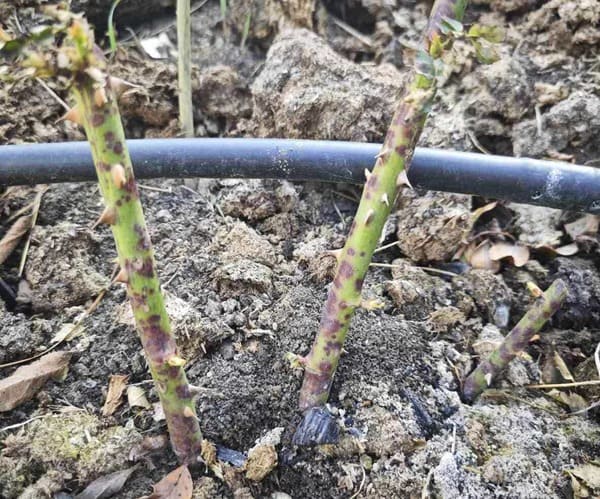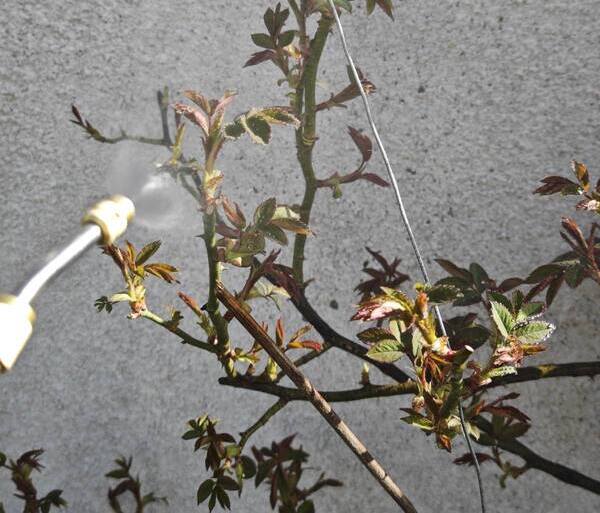Roses are stunning additions to any garden but are vulnerable to various diseases. One such condition is infectious burn (Coniothyrium fuckelii), a fungal disease that affects rose shoots, especially after winter. If left untreated, it can lead to shoot dieback and plant decline. This guide will help diagnose, treat, and prevent infectious burns, ensuring your roses stay healthy and vibrant.
Diagnosis: Infectious Burn on roses
If you notice dark spots on rose shoots, you might have infectious burns caused by the fungus Coniothyrium fuckelii.
Key Symptoms of Infectious Burn:
- Occurs after winter, especially after sudden temperature changes and high humidity.
- Dark brown or purple spots appear on shoots and gradually expand.
- In severe cases, shoots die off, leading to plant decline.
This fungal disease primarily affects weakened or stressed roses, making proper care and treatment essential.
How to Treat Infectious Burn on Roses
If your roses are affected, take the following steps immediately:
- Pruning & Removal of Infected Parts
- Cut off all affected shoots below the infected area, ensuring only healthy tissue remains.
- Use sharp, disinfected pruning shears to prevent the spreading of the infection.
- Destroy the removed plant material—do not compost it to avoid fungal spore spread.
- Treating the Wounds & Infected Areas
After pruning, disinfect the cut areas using:
- Copper sulfate solution (3%) – A strong fungicide to kill any remaining spores.
- Fungicides like Bordeaux mixture (1%) or copper-based products for effective disease control.

3. Strengthening the Rose’s Immunity
Boosting the plant’s resistance helps prevent future infections:
- In early spring, feed roses with potassium-phosphorus fertilizers to strengthen plant tissues.
- Avoid high-nitrogen fertilizers in early spring, as they promote soft growth prone to disease.
Can the Rose Bush Be Saved?
Yes! If the pruning is done correctly and all affected tissues are removed, the plant can recover. Regular monitoring and additional treatments in spring will support new, healthy growth.

Is Infectious Burn Dangerous to Other Roses?
Moderately. The fungus spreads through spores, but proper pruning and treatment can stop further infections. To protect other roses:
- Prune infected plants separately and disinfect tools after each cut.
- Apply copper-based fungicides to surrounding roses as a preventive measure.
- Improve air circulation between plants to reduce humidity and fungal growth.

Get Your Free Lunar Gardener's Calendar 2025!
Join the Lunar Gardening Revolution! Subscribe now to receive our exclusive Free Lunar Gardener’s Calendar for 2025. Harness the power of the moon to optimize your planting, nurturing, and harvesting.
How to Prevent Infectious Burn on Roses
Choose Disease-Resistant Varieties – Some rose types are naturally more resistant to fungal infections.
Improve Airflow – Space plants properly and remove excess foliage.
Regularly Inspect Roses – Catch early symptoms before they spread.
Spring & Fall Treatments – Apply Bordeaux mixture (1%) or copper-based fungicides in early spring and late fall to prevent reinfection.
Keep the Garden Clean – Remove fallen leaves and debris to stop fungal spores from overwintering.
Rose Garden Control
Infectious burns (Coniothyrium fuckelii) can be managed and prevented with prompt pruning, fungicide treatments, and proper plant care. By strengthening your roses and maintaining good hygiene practices, you can enjoy a healthy, thriving rose garden all season long!
FAQ: Infectious Burn on Roses
Yes! Roses can recover if the disease is treated promptly. Removing infected shoots, disinfecting wounds, applying appropriate fungicides, and boosting the plant’s immunity with potassium-phosphorus fertilizers can restore rose health.
Yes, infectious burns can spread among roses through fungal spores. However, careful pruning, tool disinfection, preventive treatments, and proper garden hygiene can significantly reduce the risk of further infections.
Copper-based fungicides, such as a Bordeaux mixture (1%) and a 3% copper sulfate solution, effectively control infectious burns.
Immediately upon detection, prune infected shoots below the visibly affected areas. Always use sharp, sterilized pruning shears and destroy infected plant parts rather than composting them.
Severe, untreated cases of infectious burn can eventually kill rose plants due to extensive dieback. However, timely intervention through pruning, fungicides, and immune-boosting practices usually saves affected roses.
Want more gardening tips? Subscribe to our newsletter for monthly advice straight to your inbox!



